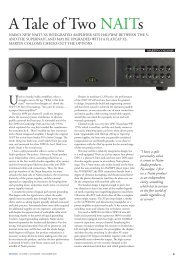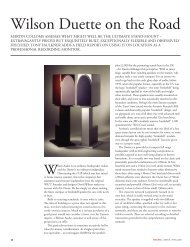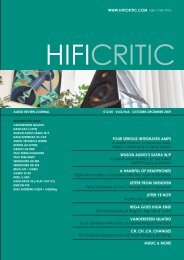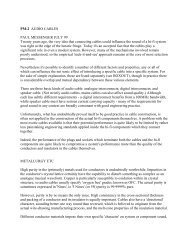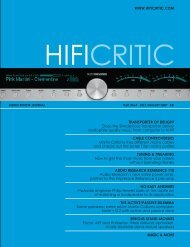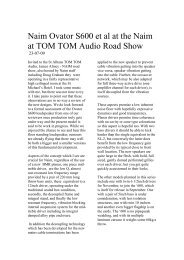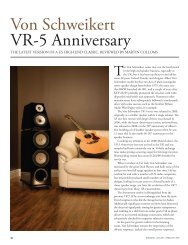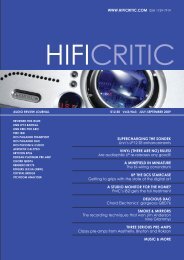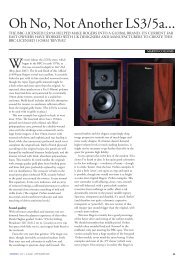The Unseen Variable - Hificritic.com
The Unseen Variable - Hificritic.com
The Unseen Variable - Hificritic.com
Create successful ePaper yourself
Turn your PDF publications into a flip-book with our unique Google optimized e-Paper software.
HIFICRITIC ARCHIVE V<br />
<strong>The</strong> <strong>Unseen</strong> <strong>Variable</strong><br />
Martin Colloms, April, 1995<br />
………………………………………………………….<br />
Although I still haven't been able to listen to the<br />
Cary Audio Design 805 single-ended tube<br />
monoblocks that Stereophile praised so highly a<br />
year ago (Vol.17 No.1, p.104), I've recently<br />
auditioned many other tubed single-ended<br />
designs. Undeniably, a good SE design has a<br />
distinctive quality of harmony and atmosphere<br />
in the midrange that reaches well beyond the<br />
average attainment of its solid-state brethren.<br />
Provided that very high sound levels and gutthumping<br />
bass are not required, Tim de<br />
Paravicini's small SE amplifier, for example,<br />
works just fine with the relatively kind and<br />
uniform 6 ohm impedance presented by a<br />
Wilson WATT V loudspeaker (used without the<br />
Puppy woofer), aided by the speaker's<br />
91dB/W/m sensitivity. Yes, the WATT V is<br />
slightly altered in character, and wide-band rock<br />
music at realistic levels is out of the question.<br />
However, with the right kind of music, the result<br />
is true high-fidelity, and can often be most<br />
beguiling-in several respects reminding me of<br />
my first experience with the original Quad<br />
electrostatic: the marvellous lack of "box" and<br />
mechanical "cone" sounds, the inaudible<br />
midrange distortion, the lightning-fast transients,<br />
and the low levels of grain.<br />
However, while electrostatics-and, for that<br />
matter, good ribbon speakers-do some things<br />
exceedingly well, ultimately they cannot always<br />
paint a <strong>com</strong>plete audio picture. I wonder<br />
whether SE amplifiers are destined to occupy a<br />
similar niche in the field of high-quality audio.<br />
In using the term "niche," I am not being<br />
derogatory-there will be many who hear the<br />
siren call and will be drawn in. For them, the<br />
purity and fluidity of the amplifier's midrange<br />
will be all that they desire. It's hard to deny that<br />
appeal if you have yet to experience a truly great<br />
system.<br />
A number of recent products have pointed to the<br />
future-in particular, the Wilson X-1/Grand<br />
SLAMM loudspeaker system I reviewed for<br />
Stereophile last December (Vol.17 No.17,<br />
p.115). Exposure to the X-1 was a revitalizing<br />
experience. It does so many things that I didn't<br />
think were possible from reproduced audio that<br />
it defines a totality of performance-a standard of<br />
excellence and listener satisfaction over the<br />
entire audible frequency range, not just the<br />
midrange.<br />
While it is SE-<strong>com</strong>patible in that its 95dB/W/m<br />
sensitivity and 6 ohm load are surprisingly<br />
amplifier-friendly, the Wilson speaker is also<br />
kind to average-quality electronics, in that it gets<br />
the best from them. At the same time, however,<br />
the X-1 is highly revealing. Once you have<br />
heard X-1 bass in full song, you will never<br />
forget how that disc you're listening to can<br />
sound. You are driven to find amplifiers that are<br />
capable of this, but you don't have many<br />
choices-try to name the tubed SE that's up to the<br />
task!<br />
<strong>The</strong> X-1's tonal balance remains true over a wide<br />
power range, provided that the source amplifier<br />
remains tonally stable. <strong>The</strong> X-1 has low<br />
distortion; at powers over a few watts, it<br />
produces less distortion than an SE amplifierand<br />
this is audible!<br />
<strong>The</strong>n there's dynamic range. While the Wilson<br />
X-1 can whisper like the thoroughbred it iscrystal-clear<br />
at milliwatt input levels-there's no<br />
doubt that it thrives on sheer power. And can it<br />
take it! Clean, undistorted power elevates the X-<br />
1/Grand SLAMM to previously unexpected<br />
regions of dynamic range, dynamics, and drama.<br />
A few hundred watts coupled with linearity and<br />
control allow the X-1 to redefine musical<br />
dynamic range in domestic replay. This is a<br />
thrilling dimension if you can get it, though it's<br />
impossible to achieve with a tubed SE design.
I've used the Wilson X-1 as an example, because<br />
its performance is audibly limited by even the<br />
finest SE tubed amplifiers-despite its nominally<br />
<strong>com</strong>patible load factor. In my own work (I don't<br />
own a pair of X-1s), I continue to find<br />
correlations to my X-1 experience. My Quad<br />
ESL-63s are sufficiently low in distortion to<br />
expose SE amplifiers once the output level rises<br />
above a few watts. <strong>The</strong>y also need at least 50W<br />
to get acceptably loud. My WATT Vs do play<br />
louder than the Quads, but they're also lowdistortion<br />
designs: single-ended amplifiers<br />
played reasonably loud sound increasingly<br />
thinner and harder tonally, and the second- and<br />
third-harmonic products be<strong>com</strong>e increasingly<br />
audible.<br />
I have had more success with higher-distortion<br />
loudspeakers averaging, say, 0.3-0.5% THD in<br />
the midband-particularly if they have smooth<br />
impedance characteristics and fairly limited bass<br />
extension. With such speakers, the sonic virtues<br />
of SE tube amplifiers stand out more clearly,<br />
confirming my view of their niche-market<br />
application.<br />
<strong>The</strong> 3.3 ohm amplifier output resistance test<br />
One of the problems for someone auditioning a<br />
good SE amplifier for the first time is that all<br />
audiophiles have a psychological need to hear a<br />
difference. Some audio differences, while<br />
important, are quite subtle. <strong>The</strong>ir analysis<br />
requires fine equipment, good circumstances,<br />
and, in some cases, extended listening.<br />
However, when <strong>com</strong>pared with a conventional,<br />
solid-state, or push-pull low-impedance tube<br />
amplifier, a single-ended tube amplifier will<br />
always sound substantially different. This is due<br />
to the <strong>com</strong>plex interaction of an SE design with<br />
typical loudspeaker loads-as well as their<br />
nonlinear behavior at high listening levels.<br />
Unfortunately, this provides immediate<br />
vindication for the listeners, reassuring them that<br />
they are skillful, sensitive, and capable.<br />
<strong>The</strong>re is therefore the attendant danger in such<br />
<strong>com</strong>parisons of confusing the acknowledged<br />
positive aspects of SE tube amplifiers with other<br />
changes. In fact, there is a distinct danger of<br />
making a virtue out of the entire sonic package.<br />
Accordingly, I designed a very simple test to see<br />
whether just one of the variables in this<br />
subjective problem can be evaluated in isolation.<br />
That variable is source impedance.<br />
In the days when "specmanship" was the name<br />
of the game, amplifier manufacturers boasted of<br />
very high damping factors-even claiming figures<br />
of several thousand in some cases. Damping<br />
factor is the ratio between the speaker load<br />
impedance-typically 8 ohms-and the output<br />
impedance of the driving amplifier.<br />
It's a trivial matter for amplifier designers to<br />
include a small fraction of the output current in<br />
the feedback loop: they can set the theoretical<br />
damping factor to infinity, or even make it<br />
negative. Even with a zero output impedance,<br />
practical damping factors are typically no better<br />
than 50 for an 8 ohm speaker (25 for a 4 ohm<br />
model), due to speaker-cable and contact<br />
resistances. (<strong>The</strong> load impedance in this<br />
discussion is defined as that existing at the<br />
loudspeaker terminals. I am treating the<br />
loudspeaker as an electro-acoustic "black box"<br />
here, not delving into its inner structure, which<br />
includes several finite resistances.)<br />
As single-ended tube amplifiers have output<br />
resistances in the 2-5 ohm range, I settled on a<br />
median value of 3.3 ohms for this investigation.<br />
This results in a damping factor (8 ohms) of just<br />
2.4.<br />
One detail required resolution: Should the<br />
listening test be conducted with the volume<br />
setting unchanged, or should the average<br />
midrange loudness be adjusted to take into<br />
account the attenuation introduced by the<br />
resistor? If the speaker system used could be<br />
considered as an 8 ohm design in the region<br />
responsible for perceived loudness, then the drop<br />
in level would be exactly 3dB.<br />
Clearly the power level should be raised to take<br />
into account this loss. But by how much? A<br />
simple rise in level is hard to judge, since the<br />
loudness gain will be uneven over the frequency<br />
range. In practice, as with loudspeaker listening<br />
tests, all the assessors can do is to judge<br />
loudness by ear (footnote 1).<br />
Two loudspeakers were auditioned for the<br />
listening tests: the Wilson WATT V and the<br />
Audio Physic Tempo. <strong>The</strong> former is a nearfield<br />
monitor, consequently showing a forward mid-
treble and a shy, well-damped bass. Used in a<br />
free-field position, its quality and character are<br />
instantly recognizable. By contrast, the Tempo<br />
(reviewed in Vol.17 Nos.8 and 11, pp.103 and<br />
169, respectively) has a full, well-developed<br />
bass octave and generally good mid-treble<br />
balance-but is perhaps a little rich in the lowtreble<br />
range. Fig.1 shows the Tempo's<br />
impedance characteristic, fig.2 its on-axis<br />
frequency response when driven by amplifiers<br />
with source impedances of 0.1 ohms and 3.3<br />
ohms, respectively.<br />
Fig.1 Audio Physic Tempo, electrical impedance<br />
magnitude (2 ohms/vertical division).<br />
Test 1, WATT V:<br />
<strong>The</strong> Watt V is nominally a 5-6 ohm loudspeaker.<br />
<strong>The</strong> calibrated loss in loudness due to the<br />
simulated source resistance was therefore a<br />
substantial 3.6dB. (Note that with an evenlower-impedance<br />
speaker, the output impedance<br />
of a tube SE amplifier will result in an even<br />
greater loss in loudness.) No sense could be<br />
made of the <strong>com</strong>parison, so I raised the volume<br />
by 4dB to match the subjective loudnesses.<br />
What a fascinating result! <strong>The</strong> resistor feed<br />
dramatically shifted the tonal balance of the<br />
Wilson WATT, with the general view that it<br />
now sounded more like a free-field-optimized<br />
design. In particular, the bass was louder and<br />
better balanced with the series resistor, revealing<br />
pretty good power and extension. <strong>The</strong> midrange<br />
sounded open, fast, and articulate, the treble airy<br />
and sparkling. <strong>The</strong> balance was a little brighter<br />
than before, but not to the point of upsetting the<br />
overall presentation. If anything, stereo<br />
perspectives were judged to be superior, with<br />
increased spaciousness and a more holographic<br />
projection of midrange depth.<br />
Forgive me if I point out at this juncture that<br />
some of these characteristics are often promoted<br />
by the manufacturers of costly SE tubed<br />
amplifiers, and yet here they were achieved by<br />
the simple use of a resistor costing just 50 cents!<br />
It must also be noted that, while the above does<br />
describe a genuine quality improvement in the<br />
case of the WATT V "misused" in a free-field<br />
application, there were none of the engineering<br />
elements present that could be associated with<br />
better sound-such as a better amplifier.<br />
Test 2, Tempo:<br />
Fig.2 Audio Physic Tempo, on-axis frequency<br />
response when driven by an amplifier with an<br />
output impedance of 0.1 ohms (top) and 3.3<br />
ohms (bottom). Note overall drop in level and<br />
significant change in midrange balance<br />
(5dB/vertical division).<br />
Footnote 1: In Stereophile's <strong>com</strong>parative<br />
loudspeaker listening tests, we have found that<br />
equalizing the B-weighted spls does give<br />
subjectively similar loudnesses.-JA<br />
While the calculated loss was 3dB, given its<br />
nominal 8 ohm load, the subjective loudness of<br />
the Tempo was not greatly impaired by the 3.3<br />
ohm series resistor. If anything, certain<br />
frequency regions, such as the midbass, were<br />
slightly louder. Overall, without any attempt at<br />
level matching, the bass loudness was similar<br />
but less even, with a loss of extension.<br />
Interestingly, the bass did not sound<br />
significantly boomier or less well-controlled. On<br />
a more subtle level, the listeners perceived<br />
losses in bass rhythm and impact.
Perceptible shifts in tonality were apparent-there<br />
seemed to be more presence and edge definition,<br />
yet these were achieved without hardness or<br />
glare. <strong>The</strong> sound appeared to have opened out<br />
somewhat. And, again, a feeling of enhanced<br />
focus was heard in the midrange, though the<br />
impression of depth was now thought to be<br />
impaired.<br />
Remember that the <strong>com</strong>plexity of the human<br />
hearing process will mean that some of these<br />
observed effects result from subtle loudness<br />
changes alone. For example, one effect of a<br />
slight drop in level is to increase the sense of<br />
distance from the perceived soundsources.<br />
For the next set of <strong>com</strong>parisons, the replay level<br />
with the series resistor was increased by 2.5dB<br />
to restore the subjective impact and loudness of<br />
the program material. Now those previously<br />
misleading interpretations of fidelity caused by<br />
level reductions in certain frequency regions<br />
were blown away. This speaker, with its<br />
relatively neutral balance, was recognized as<br />
showing clear signs of a warped personality with<br />
the series resistor!<br />
<strong>The</strong> Tempo sounded less neutral with the series<br />
resistor. Its vocal balance, for example, was<br />
lightened and higher pitched. Cellos were<br />
emasculated, sounding more like violas than<br />
cellos, while the treble was projected. This can<br />
be attractive on some dull-sounding material, but<br />
causes undesirable emphasis on others. <strong>The</strong><br />
Tempo's bass was now unquestionably inferior<br />
to that with normal drive. Less even and wellcontrolled,<br />
the low frequencies were less a part<br />
of the whole sound. By whatever psychoacoustic<br />
association was at work, the bass appeared to<br />
lose drive and impact, percussive power and<br />
rhythm.<br />
On the plus side, gains were perceived in the<br />
midrange focus, depth, and perspective-these are<br />
the sorts of changes a speaker designer can<br />
introduce by judicious control of frequency<br />
response within a specified tolerance (see the<br />
sidebar). Often a price has to be paid for such<br />
indiscretions, different kinds of music revealing<br />
them as false tonal emphases or colorations.<br />
Comment<br />
<strong>The</strong>se anecdotal tests only go to show the<br />
remarkable <strong>com</strong>plexity of sound-quality changes<br />
that can result from using an amplifier with a<br />
significant source impedance. Even experienced<br />
critics-sorry, I do place myself in this categoryfind<br />
it very difficult, if not impossible, to<br />
separate these physical and acoustic interactions<br />
from the overall perception of sound quality. We<br />
have to accept that moderate tone-control<br />
effects-unfamiliar response changes over limited<br />
sections of the overall frequency range, allied to<br />
changes in level-can significantly alter perceived<br />
sound quality in all its many aspects. And, in my<br />
view, it isn't possible with any confidence to<br />
separate the sound of an amplifier from the<br />
changes it may impart to the frequency response<br />
and bass damping of a specific loudspeaker.<br />
A tubed SE amplifier may be of very high<br />
intrinsic quality, but its sound will always be<br />
hard to pin down, due to this unavoidable load<br />
interaction. <strong>The</strong> one exception will be with<br />
loudspeakers that have flat impedance<br />
characteristics. However, as such speakers tend<br />
to be 4 ohm designs, there will be an undue loss<br />
of overall power when they are driven by singleended<br />
tube amplifiers-something that is hard to<br />
accept given the limited power delivery<br />
available from such amplifiers.<br />
Evaluations of SE amplifiers tend, therefore, to<br />
degenerate into a search for that one special<br />
speaker-generally an off-the-beaten-track<br />
design-that has exactly the right response and<br />
impedance characteristics that its sound will be<br />
optimized when driven by an SE amp. Thus, the<br />
critic is rewarded, his skill in "system matching"<br />
vindicated, and the SE amplifier transports him<br />
to audio heaven.<br />
A case history<br />
To close, I offer a real-life example of an<br />
experienced critic who got the right musical<br />
result with an SE amplifier for the wrong<br />
reasons, and in the process unknowingly<br />
corrected a speaker problem.<br />
My colleague Ken Kessler and I recently cowrote<br />
a review of the Wilson WATT/Puppy V<br />
speaker system for the English magazine Hi-Fi<br />
News & Record Review ( HFN/RR, January<br />
1995, p.28.). We ran into some trouble in our<br />
assessment of the speaker. <strong>The</strong> test samples had<br />
been drawn from early production, which had<br />
generally been well-received by customers in the<br />
US.
Though the speaker's balance was fine in large<br />
listening spaces-especially in US-style timberframe<br />
houses-a moderate flaw in the form of an<br />
excess in upper bass centered on 90Hz became<br />
apparent, even obvious, in smaller roomsespecially<br />
in apartments and houses of concrete<br />
or brick construction.<br />
Ken bravely fought the fight for system<br />
matching, discovering that he could optimize the<br />
sound of the Wilson System V. His intuitive<br />
solution was to drive the speakers with singleended<br />
amplifiers: the Cary 805, a Unison<br />
Research from Italy, and the Paravicini-designed<br />
EAR 954. Using these amplifiers, Ken was<br />
amazed to find that, contrary to his expectations,<br />
the upper-bass excess of the Wilson speaker had<br />
been tamed. "Amazed" because, given the<br />
intrinsically good sound quality of these SE<br />
amplifiers, we know that the WATT Puppy is a<br />
pretty rough load, and that historically it has<br />
favored tight, gutsy amplifiers-generally solidstate.<br />
I found the answer to this apparent paradox<br />
while performing the test mentioned in this<br />
article. It turns out that, while the new WATT is<br />
close to a 6 ohm load and is fairly constant over<br />
the main frequency range, the new Puppy is a<br />
tougher load than the old, falling to around 2.5<br />
ohms in the 90Hz region, and typically<br />
averaging 4 ohms. Now Ken's results could be<br />
explained! <strong>The</strong> high SE source impedance acted<br />
as an attenuator/damper for the Puppy,<br />
depressing its errant upper bass. In addition, the<br />
upper range covered by the WATT was now<br />
attenuated less overall, changing the balance<br />
between the two units.<br />
<strong>The</strong> figures are instructive: assuming a 3.3 ohm<br />
SE source, the WATT is attenuated by 3.8dB.<br />
<strong>The</strong> Puppy, however, is stepped back by an<br />
average of 5.2dB, and by 7.2dB at 90Hz. Given<br />
tolerances for the exact value of source<br />
impedance in the frequency range concerned,<br />
you have exactly the -3dB correction this<br />
speaker requires (Note Since October 1994, the<br />
Puppy V has been fitted with a resistor to the<br />
crossover. This damps the Puppy's motional<br />
impedance interaction with the crossover,<br />
thereby giving 3dB of control at 90Hz-the<br />
offending point.0<br />
Ken's story was concluded with Wilson Audio<br />
supplying the factory-specified 15 ohm damping<br />
resistors for the Puppy woofers. With these<br />
connected across the outputs of the woofer<br />
crossover feeds-an easy retrofit-the system now<br />
sounded bass-light and lacking in slam when<br />
driven by the SE amplifiers, mandating Ken<br />
returning to a gutsy, solid-state amplifier to<br />
<strong>com</strong>plete his evaluation.<br />
It is easy to extrapolate from this tale to other<br />
circumstances. Consider, for example, a neutral<br />
speaker that is not optimally placed in a room. A<br />
high amplifier impedance may, in conjunction<br />
with that speaker's characteristic load<br />
impedance, deliver a better tonal result. Most of<br />
the credit will go to the change in amplifier, not<br />
to the unseen variable of source impedance.<br />
Sidebar: Sonic Speaker Tailoring<br />
It's not readily appreciated that a loudspeaker's<br />
treble balance exercises a powerful control over<br />
perceived clarity, right into the midrange. <strong>The</strong><br />
perception of a loudspeaker's quality hinges<br />
strongly on the balance the designer has<br />
achieved between the midrange and treble<br />
levels-both in the on-axis frequency response<br />
and in the acoustic power delivered to the room.<br />
This is very critical, and if a speaker system<br />
lacks sufficient clarity, the designer may be led,<br />
intuitively or deliberately, to lift the treble power<br />
to improve things. It is amazing what can<br />
happen with as little as 0.5-1dB of treble lift, but<br />
this is a very dangerous procedure, as too much<br />
treble energy will disturb the neutrality and<br />
tonal accuracy of the sound. Violins be<strong>com</strong>e<br />
edgy, flutes breathy, and vocalists have too<br />
much toothy or sibilant emphasis. In addition,<br />
treble-dominant sounds no longer sit back in the<br />
soundstage, where the record producer intended<br />
them to be.-Martin Colloms




